Neuronal avalanches are diverse and precise activity patterns that are stable for many hours in cortical slice cultures
- PMID: 15175392
- PMCID: PMC6729198
- DOI: 10.1523/JNEUROSCI.0540-04.2004
Neuronal avalanches are diverse and precise activity patterns that are stable for many hours in cortical slice cultures
Abstract
A major goal of neuroscience is to elucidate mechanisms of cortical information processing and storage. Previous work from our laboratory (Beggs and Plenz, 2003) revealed that propagation of local field potentials (LFPs) in cortical circuits could be described by the same equations that govern avalanches. Whereas modeling studies suggested that these "neuronal avalanches" were optimal for information transmission, it was not clear what role they could play in information storage. Work from numerous other laboratories has shown that cortical structures can generate reproducible spatiotemporal patterns of activity that could be used as a substrate for memory. Here, we show that although neuronal avalanches lasted only a few milliseconds, their spatiotemporal patterns were also stable and significantly repeatable even many hours later. To investigate these issues, we cultured coronal slices of rat cortex for 4 weeks on 60-channel microelectrode arrays and recorded spontaneous extracellular LFPs continuously for 10 hr. Using correlation-based clustering and a global contrast function, we found that each cortical culture spontaneously produced 4736 +/- 2769 (mean +/- SD) neuronal avalanches per hour that clustered into 30 +/- 14 statistically significant families of spatiotemporal patterns. In 10 hr of recording, over 98% of the mutual information shared by these avalanche patterns were retained. Additionally, jittering analysis revealed that the correlations between avalanches were temporally precise to within +/-4 msec. The long-term stability, diversity, and temporal precision of these avalanches indicate that they fulfill many of the requirements expected of a substrate for memory and suggest that they play a central role in both information transmission and storage within cortical networks.
Figures
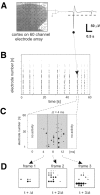
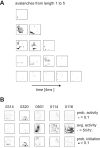

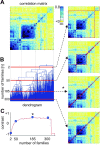
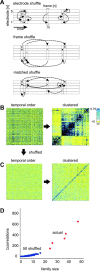



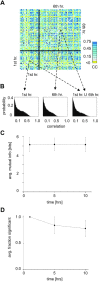



References
-
- Abeles M, Bergman H, Margalit E, Vaadia E (1993) Spatiotemporal firing patterns in the frontal cortex of behaving monkeys. J Neurophysiol 70: 1629–1638. - PubMed
-
- Albowitz B, Kuhnt U, Ehrenreich L (1990) Optical recording of epileptiform voltage changes in the neocortical slice. Exp Brain Res 81: 241–256. - PubMed
-
- Beggs JM, Plenz D (2001). Diversity and stability of elementary activity patterns that spontaneously form in isolated cortex. Soc Neurosci Abstr 27: 64.7.
-
- Biella G, Forti M, de Curtis M (1996) Propagation of epileptiform potentials in the guinea-pig piriform cortex is sustained by associative fibres. Epilepsy Res 24: 137–146. - PubMed
MeSH terms
LinkOut - more resources
Full Text Sources
Other Literature Sources
Medical
